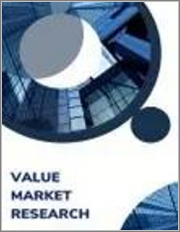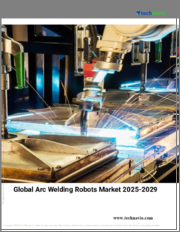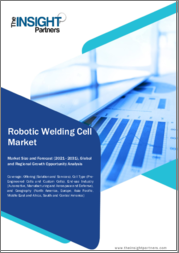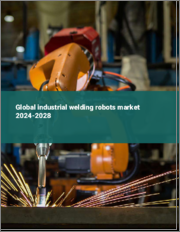
|
시장보고서
상품코드
1342907
세계의 로봇 용접 셀 시장 조사 보고서 : 산업 분석, 규모, 점유율, 성장, 동향, 예측(2023-2030년)Global Robotic Welding Cell Market Research Report - Industry Analysis, Size, Share, Growth, Trends and Forecast 2023 to 2030 |
||||||
로봇 용접 셀 시장의 세계 수요는 2023-2030년 동안 9.72%의 CAGR로 2022년 44억 6,000만 달러에서 2030년 거의 102억 8,000만 달러의 시장 규모에 도달할 것으로 추정됩니다.
로봇 용접 셀은 금속 용접기입니다. 로봇 용접 셀에는 용융 금속을 "보고" "만지는" 두 개 이상의 로봇 팔이 있습니다. 로봇 팔이 용융 금속을 움직여 그것을 집어 들고 용접합니다. 로봇 용접 셀은 금속 구조물에 금속 시트의 용접을 자동화하는 데 사용되며, 산업은 대량의 금속 부품을 신속하게 생산할 수 있습니다. 로봇 용접 셀은 인간과 동일한 작업을 수행 할 수 있지만 임금은 훨씬 낮고 스트레스가 적습니다.
시장 역학:
산업계의 자동화 수요 증가와 기술 발전이 로봇 용접 셀 시장의 수요를 견인할 것으로 예상됩니다. 또한, 전자 및 기계와 같은 제조 분야에 대한 막대한 투자가 예측 기간 동안 로봇 용접 셀에 대한 수요를 촉진할 것으로 예상됩니다. 또한, 로봇 용접 셀은 추가 생산 인력을 고용하지 않고도 적은 인력으로 다양한 용접 공정을 수행하기 때문에 전 세계 자동차, 전자, 항공우주, 방위, 건설 및 광업 산업에서 사용하기에 적합합니다. 또한 다양한 산업 분야의 로봇 기술 연구 개발 활동에 대한 대규모 투자는 용접 로봇을 개발하기 위해 새로운 첨단 기술의 사용을 촉진하고 있습니다. 그러나 로봇 용접 셀을 설치하는 데 드는 높은 초기 비용이 이 시장의 성장을 억제할 것으로 예상됩니다.
조사 보고서는 Porter's Five Forces 모델, 시장 매력도 분석, 밸류체인 분석을 다루고 있습니다. 이러한 도구는 업계의 구조를 명확하게 파악하고 세계 수준에서 경쟁의 매력을 평가하는 데 도움이됩니다. 또한 이러한 도구는 로봇 용접 셀 세계 시장에서 각 부문을 포괄적으로 평가할 수 있습니다. 로봇 용접 셀 산업의 성장과 동향은 이 조사에 대한 전체적인 접근 방식을 제공합니다.
지역별 분석:
이 섹션에서는 북미, 유럽, 아시아태평양, 라틴아메리카, 중동 및 아프리카의 로봇 용접 셀 시장의 현재와 미래 수요를 강조하는 지역 전망을 다룹니다. 또한, 모든 주요 지역의 개별 애플리케이션 부문의 수요, 추정 및 예측에 초점을 맞추고 있습니다.
요청이 있으시면 저희에게 연락 주시기 바랍니다. 저희 조사팀은 고객의 요구에 따라 맞춤형 보고서를 제공할 수 있습니다.
목차
제1장 서문
제2장 주요 요약
- 시장 하이라이트
- 세계 시장 현황
제3장 로봇 용접 셀 - 산업 분석
- 서론 : 시장 역학
- 시장 성장 촉진요인
- 시장 성장 억제요인
- 시장 기회
- 산업 동향
- Porter's Five Forces 분석
- 시장 매력도 분석
제4장 밸류체인 분석
- 밸류체인 분석
- 원재료 분석
- 원재료 리스트
- 원재료 제조업체 리스트
- 주요 원재료 가격 동향
- 잠재적 바이어 리스트
- 마케팅 채널
- 직접 마케팅
- 간접 마케팅
- 마케팅 채널 발전 동향
제5장 COVID-19 발생의 영향 분석
제6장 로봇 용접 셀 세계 시장 분석 : 유형별
- 유형별 개요
- 실적 데이터와 예측 데이터
- 유형별 분석
- 아크 용접
- 스팟 용접
- 기타
제7장 로봇 용접 셀 세계 시장 분석 : 페이로드별
- 페이로드별 개요 페이로드별
- 실적과 예측
- 분석
- 50kg 이하
- 50-150kg
- 150kg 이상
제8장 로봇 용접 셀 세계 시장 분석 : 최종사용자별
- 최종사용자별 개요
- 실적 데이터와 예측 데이터
- 최종사용자별 분석
- 자동차·수송
- 금속·기계
- 전기·전자
- 항공우주·방위
- 기타
제9장 로봇 용접 셀 세계 시장 매출 분석 : 지역별
- 지역별 전망 판매 분석
- 서론 판매 분석
- 북미의 매출 분석
- 개요, 실적과 예측
- 북미 : 부문별
- 북미 : 국가별
- 미국
- 캐나다
- 멕시코
- 유럽 매출 분석
- 개요, 실적과 예측
- 유럽 : 부문별
- 유럽 : 국가별
- 영국
- 프랑스
- 독일
- 이탈리아
- 러시아
- 기타 유럽
- 아시아태평양 매출 분석
- 개요, 실적과 예측
- 아시아태평양 : 부문별
- 아시아태평양 : 국가별
- 중국
- 인도
- 일본
- 한국
- 호주
- 기타 아시아태평양
- 라틴아메리카 매출 분석
- 개요, 실적과 예측
- 라틴아메리카 : 부문별
- 라틴아메리카 : 국가별
- 브라질
- 아르헨티나
- 페루
- 칠레
- 기타 라틴아메리카
- 중동 및 아프리카 매출 분석
- 개요, 실적과 예측
- 중동 및 아프리카 : 부문별
- 중동 및 아프리카 : 국가별
- 사우디아라비아
- 아랍에미리트
- 이스라엘
- 남아프리카공화국
- 기타 중동 및 아프리카
제10장 로봇 용접 셀 기업 경쟁 상황
- 로봇 용접 셀 시장 경쟁
- 제휴, 협력, 합의
- 인수합병
- 신제품 발표
- 기타 개발
제11장 기업 개요
- 상위 10개사 점유율 분석
- 시장 집중도
- FANUC Corporation(일본)
- YASKAWA Electric Corporation(일본)
- KUKA AG(독일)
- ABB(스위스)
- Kawasaki Heavy Industries Ltd.(일본)
- Panasonic Corporation(일본)
- DAIHEN Corporation(일본)
- NACHI-FUJIKOSHI CORP.(일본)
- Comau S.p.A.(이탈리아)
- Hyundai Robotics(한국)
The global demand for Robotic Welding Cell Market is presumed to reach the market size of nearly USD 10.28 BN by 2030 from USD 4.46 BN in 2022 with a CAGR of 9.72% under the study period 2023 - 2030.
Robotic welding cell is a metal welding machine. Robotic welding cell has two or more robotic arms like ''see'' and ''touch'' the molten metal. The robot arms move the molten metal, which picks it up and welds it together. Robotic welding cells are used to automate the welding of metal sheets onto metal structures, allowing the industry to quickly produce large quantities of metal parts. Robotic welding cells can do the same job as humans but with much lower wages and less stress.
MARKET DYNAMICS:
The growing need for automation in industries and significant technological advancements are expected to drive the robotic welding cell market demand. Moreover, huge investments in manufacturing sectors such as electronics and machinery are expected to drive demand for robotic welding cells over the forecast period. Furthermore, robotic welding cell performs different welding processes with less workforce and without hiring additional production staff which makes it suitable for use in the automotive, electronics, aerospace, defense, construction, and mining industries worldwide. In addition, large investments in robot technology research and development activities in various industries are driving the use of new advanced technologies to develop welding robots. However, the high initial cost of installing welding robots cell is expected to restrain the growth of this market.
The research report covers Porter's Five Forces Model, Market Attractiveness Analysis, and Value Chain analysis. These tools help to get a clear picture of the industry's structure and evaluate the competition attractiveness at a global level. Additionally, these tools also give an inclusive assessment of each segment in the global market of robotic welding cell. The growth and trends of robotic welding cell industry provide a holistic approach to this study.
MARKET SEGMENTATION:
This section of the robotic welding cell market report provides detailed data on the segments at country and regional level, thereby assisting the strategist in identifying the target demographics for the respective product or services with the upcoming opportunities.
By Type
- Arc Welding
- Spot Welding
- Others
By Payload
- <50 Kg Payload
- 50-150 Kg Payload
- >150 Kg Payload
By End User
- Automotive & Transportation
- Metals And Machinery
- Electrical And Electronics
- Aerospace & Defense
- Others
REGIONAL ANALYSIS:
This section covers the regional outlook, which accentuates current and future demand for the Robotic Welding Cell market across North America, Europe, Asia-Pacific, Latin America, and Middle East & Africa. Further, the report focuses on demand, estimation, and forecast for individual application segments across all the prominent regions.
The research report also covers the comprehensive profiles of the key players in the market and an in-depth view of the competitive landscape worldwide. The major players in the robotic welding cell market include FANUC Corporation (Japan), YASKAWA Electric Corporation (Japan), KUKA AG (Germany), ABB (Switzerland), Kawasaki Heavy Industries, Ltd. (Japan), Panasonic Corporation (Japan), DAIHEN Corporation (Japan), NACHI-FUJIKOSHI CORP. (Japan), Comau S.p.A. (Italy), and Hyundai Robotics (South Korea). This section consists of a holistic view of the competitive landscape that includes various strategic developments such as key mergers & acquisitions, future capacities, partnerships, financial overviews, collaborations, new product developments, new product launches, and other developments.
In case you have any custom requirements, do write to us. Our research team can offer a customized report as per your need.
TABLE OF CONTENTS
1 . PREFACE
- 1.1. Report Description
- 1.1.1. Objective
- 1.1.2. Target Audience
- 1.1.3. Unique Selling Proposition (USP) & offerings
- 1.2. Research Scope
- 1.3. Research Methodology
- 1.3.1. Market Research Process
- 1.3.2. Market Research Methodology
2 . EXECUTIVE SUMMARY
- 2.1. Highlights of Market
- 2.2. Global Market Snapshot
3 . ROBOTIC WELDING CELL - INDUSTRY ANALYSIS
- 3.1. Introduction - Market Dynamics
- 3.2. Market Drivers
- 3.3. Market Restraints
- 3.4. Opportunities
- 3.5. Industry Trends
- 3.6. Porter's Five Force Analysis
- 3.7. Market Attractiveness Analysis
- 3.7.1 Market Attractiveness Analysis By Type
- 3.7.2 Market Attractiveness Analysis By Payload
- 3.7.3 Market Attractiveness Analysis By End User
- 3.7.4 Market Attractiveness Analysis By Region
4 . VALUE CHAIN ANALYSIS
- 4.1. Value Chain Analysis
- 4.2. Raw Material Analysis
- 4.2.1. List of Raw Materials
- 4.2.2. Raw Material Manufactures List
- 4.2.3. Price Trend of Key Raw Materials
- 4.3. List of Potential Buyers
- 4.4. Marketing Channel
- 4.4.1. Direct Marketing
- 4.4.2. Indirect Marketing
- 4.4.3. Marketing Channel Development Trend
5 . IMPACT ANALYSIS OF COVID-19 OUTBREAK
6 . GLOBAL ROBOTIC WELDING CELL MARKET ANALYSIS BY TYPE
- 6.1 Overview by Type
- 6.2 Historical and Forecast Data
- 6.3 Analysis by Type
- 6.4 Arc Welding Historic and Forecast Sales by Regions
- 6.5 Spot Welding Historic and Forecast Sales by Regions
- 6.6 Others Historic and Forecast Sales by Regions
7 . GLOBAL ROBOTIC WELDING CELL MARKET ANALYSIS BY PAYLOAD
- 7.1 Overview by Payload
- 7.2 Historical and Forecast Data
- 7.3 Analysis by Payload
- 7.4 <50 kg Payload Historic and Forecast Sales by Regions
- 7.5 50-150 kg Payload Historic and Forecast Sales by Regions
- 7.6 >150 kg Payload Historic and Forecast Sales by Regions
8 . GLOBAL ROBOTIC WELDING CELL MARKET SALES ANALYSIS BY END USER
- 8.1 Overview by End User
- 8.2 Historical and Forecast Data
- 8.3 Analysis by End User
- 8.4 Automotive & Transportation Historic and Forecast Sales by Regions
- 8.5 Metals and Machinery Historic and Forecast Sales by Regions
- 8.6 Electrical and Electronics Historic and Forecast Sales by Regions
- 8.7 Aerospace & Defense Historic and Forecast Sales by Regions
- 8.8 Others Historic and Forecast Sales by Regions
9 . GLOBAL ROBOTIC WELDING CELL MARKET SALES ANALYSIS BY GEOGRAPHY
- 9.1. Regional Outlook Sales Analysis
- 9.2. Introduction Sales Analysis
- 9.3. North America Sales Analysis
- 9.3.1. Overview, Historic and Forecast Sales Analysis
- 9.3.2. North America By Segment Sales Analysis
- 9.3.3. North America By Country Sales Analysis
- 9.3.4. United State Sales Analysis
- 9.3.5. Canada Sales Analysis
- 9.3.6. Mexico Sales Analysis
- 9.4. Europe Sales Analysis
- 9.4.1. Overview, Historic and Forecast Sales Analysis
- 9.4.2. Europe by Segment Sales Analysis
- 9.4.3. Europe by Country Sales Analysis
- 9.4.4. United Kingdom Sales Analysis
- 9.4.5. France Sales Analysis
- 9.4.6. Germany Sales Analysis
- 9.4.7. Italy Sales Analysis
- 9.4.8. Russia Sales Analysis
- 9.4.9. Rest Of Europe Sales Analysis
- 9.5. Asia Pacific Sales Analysis
- 9.5.1. Overview, Historic and Forecast Sales Analysis
- 9.5.2. Asia Pacific by Segment Sales Analysis
- 9.5.3. Asia Pacific by Country Sales Analysis
- 9.5.4. China Sales Analysis
- 9.5.5. India Sales Analysis
- 9.5.6. Japan Sales Analysis
- 9.5.7. South Korea Sales Analysis
- 9.5.8. Australia Sales Analysis
- 9.5.9. Rest Of Asia Pacific Sales Analysis
- 9.6. Latin America Sales Analysis
- 9.6.1. Overview, Historic and Forecast Sales Analysis
- 9.6.2. Latin America by Segment Sales Analysis
- 9.6.3. Latin America by Country Sales Analysis
- 9.6.4. Brazil Sales Analysis
- 9.6.5. Argentina Sales Analysis
- 9.6.6. Peru Sales Analysis
- 9.6.7. Chile Sales Analysis
- 9.6.8. Rest of Latin America Sales Analysis
- 9.7. Middle East & Africa Sales Analysis
- 9.7.1. Overview, Historic and Forecast Sales Analysis
- 9.7.2. Middle East & Africa by Segment Sales Analysis
- 9.7.3. Middle East & Africa by Country Sales Analysis
- 9.7.4. Saudi Arabia Sales Analysis
- 9.7.5. UAE Sales Analysis
- 9.7.6. Israel Sales Analysis
- 9.7.7. South Africa Sales Analysis
- 9.7.8. Rest Of Middle East And Africa Sales Analysis
10 . COMPETITIVE LANDSCAPE OF THE ROBOTIC WELDING CELL COMPANIES
- 10.1. Robotic Welding Cell Market Competition
- 10.2. Partnership/Collaboration/Agreement
- 10.3. Merger And Acquisitions
- 10.4. New Product Launch
- 10.5. Other Developments
11 . COMPANY PROFILES OF ROBOTIC WELDING CELL INDUSTRY
- 11.1. Top 10 Company Share Analysis
- 11.2. Market Concentration Rate
- 11.3. FANUC Corporation (Japan)
- 11.3.1. Company Overview
- 11.3.2. Company Revenue
- 11.3.3. Products
- 11.3.4. Recent Developments
- 11.4. YASKAWA Electric Corporation (Japan)
- 11.4.1. Company Overview
- 11.4.2. Company Revenue
- 11.4.3. Products
- 11.4.4. Recent Developments
- 11.5. KUKA AG (Germany)
- 11.5.1. Company Overview
- 11.5.2. Company Revenue
- 11.5.3. Products
- 11.5.4. Recent Developments
- 11.6. ABB (Switzerland)
- 11.6.1. Company Overview
- 11.6.2. Company Revenue
- 11.6.3. Products
- 11.6.4. Recent Developments
- 11.7. Kawasaki Heavy Industries Ltd. (Japan)
- 11.7.1. Company Overview
- 11.7.2. Company Revenue
- 11.7.3. Products
- 11.7.4. Recent Developments
- 11.8. Panasonic Corporation (Japan)
- 11.8.1. Company Overview
- 11.8.2. Company Revenue
- 11.8.3. Products
- 11.8.4. Recent Developments
- 11.9. DAIHEN Corporation (Japan)
- 11.9.1. Company Overview
- 11.9.2. Company Revenue
- 11.9.3. Products
- 11.9.4. Recent Developments
- 11.10. NACHI-FUJIKOSHI CORP. (Japan)
- 11.10.1. Company Overview
- 11.10.2. Company Revenue
- 11.10.3. Products
- 11.10.4. Recent Developments
- 11.11. Comau S.p.A. (Italy)
- 11.11.1. Company Overview
- 11.11.2. Company Revenue
- 11.11.3. Products
- 11.11.4. Recent Developments
- 11.12. Hyundai Robotics (South Korea)
- 11.12.1. Company Overview
- 11.12.2. Company Revenue
- 11.12.3. Products
- 11.12.4. Recent Developments



















